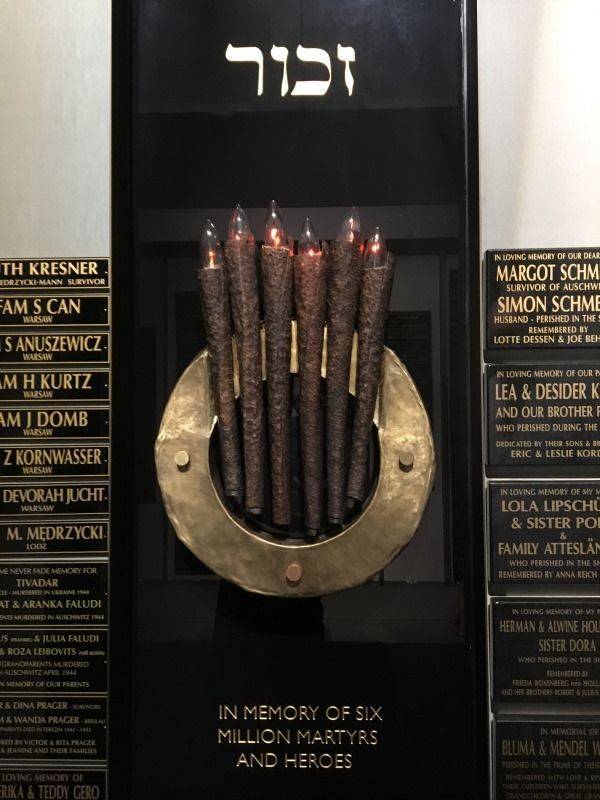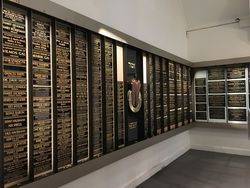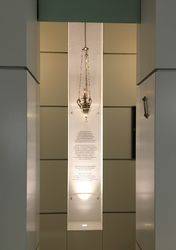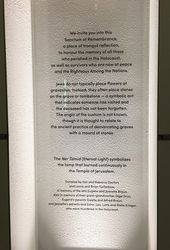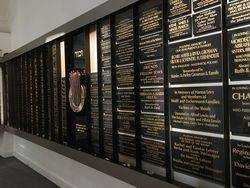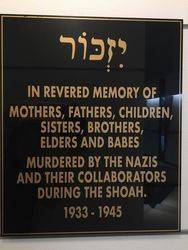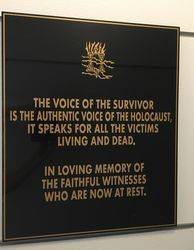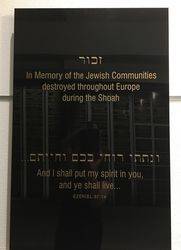
Sanctum of Remembrance Print Page 
The Sanctum of Remembrance was opened in 1992 in conjunction with the Australian Association of Holocaust Survivors and Descendants. The initial Sanctum had space for the laying of 100 plaques. Ten years later, in 2002, the Museum expanded the Sanctum to accommodate a growing number of requests to honour Holocaust victims.
Currently, the Sanctum of Remembrance holds close to 500 plaques dedicated to individual survivors and victims, to entire communities and families, and to extraordinary individuals who saved Jewish lives a the risk of their own lives. There is still room for descendants and the next generations to lay plaques in memory of loved ones.
The Ner Tamid Light was donated by Ilan and Rebecca Doctors and Leora and Brian Turtledove, in memory of the late Eugene and Jeanette Braun. Also in memory of their great-grandmother Olga Brun, Eugene's parents Gizella and Alfred Braun, and Jeanette`s parents and sister Leo, Lotte and Stella Krieger who were murdered in the Holocaust.
The Holocaust was the systematic, bureaucratic, state-sponsored persecution and murder of six million Jews by the Nazi regime and its collaborators. Holocaust is a word of Greek origin meaning "sacrifice by fire." The Nazis, who came to power in Germany in January 1933, believed that Germans were "racially superior" and that the Jews, deemed "inferior," were an alien threat to the so-called German racial community.
During the era of the Holocaust, German authorities also targeted other groups because of their perceived racial and biological inferiority: Roma (Gypsies), people with disabilities, and some of the Slavic peoples (Poles, Russians, and others). Other groups were persecuted on political, ideological, and behavioral grounds, among them Communists, Socialists, Jehovah`s Witnesses, and homosexuals.
Location
| Address: | 148 Darlinghurst Road, Sydney Jewish Museum, Darlinghurst, 2011 |
|---|---|
| State: | NSW |
| Area: | AUS |
| GPS Coordinates: | Lat: -33.878981 Long: 151.220135 Note: GPS Coordinates are approximate. |
Details
| Monument Type: | Monument |
|---|---|
| Monument Theme: | Conflict |
| Sub-Theme: | Genocide |
| Actual Event Start Date: | 1933 |
| Actual Event End Date: | 1945 |
Dedication
| Approx. Monument Dedication Date: | 1992 |
|---|
In memory of six million martyrs and heroes
[ Names ]
Plaque :
In memory of the Jewish communities destroyed throughout Europe during the Shoah
And I shall put my spirit in you, and ye shall live.... Ezekial 37:14
Plaque :
In revered memory of mothers, fathers, children, sisters, brothers, elders and babes murdered by the Nazis and their collaborators during the Shoah
1933 -1945
Plaque :
The voice of the survivor is the authentic voice of the Holocaust, it speaks for all the victims living and dead
In loving memory of the faithfull witnesses who are now at rest.
We invite you to this Sanctum of Remembrance. a place of tranquil reflection, to honour the memory of those who perished in the Holocaust, as well as survivors who are now at peace and the Righteous Among the Nations.
Jews do not typically place flowers at gravesites. Instead, they often place stones on the grave or tombstone - a symbolic act that indicates someone has visited and the deceased has not been forgotten. The origin of the custom is not known though it is thought to relate to the ancient practice of demarcating graves with a mound of stones.
The Ner Tamid (Eternal Light) symbolises the lamp that burned continuously in the Temple of Jerusalem.


